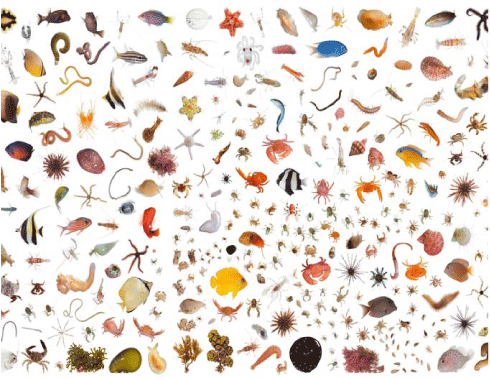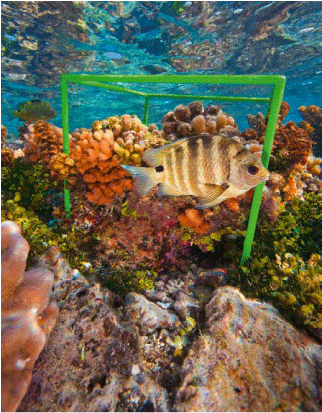

Within One Cubic Foot
 |
When you thrust a shovel into the soil or tear off a piece of coral, you are cutting through
an entire world.
You have crossed a hidden frontier known to very few. Immediately close at hand,
around and beneath our feet, lies the least explored part of the planet›s surface.
It is also the most vital place on Earth for human existence.
By Edward O. Wilson*
In any habitat, on the ground, in the forest canopy, or in the water, your eye is first caught by the big animals, birds, mammals, fish, butterflies. But gradually the smaller inhabitants, far more numerous, begin to eclipse them. There are the insect myriads creeping and buzzing among the weeds, the worms and unnameable creatures that squirm or scuttle for cover when you turn garden soil for planting. There are those annoying ants that swarm out when their nest is accidentally cut open and the pesky beetl? grubs exposed at yellowed grass roots. When you flip a rock over, there are even more: You see spiderlings and sundry pale unknowns of diverse form slinking through mats of fungus strands. Tiny beetles hide from the sudden light, and pill bugs curl their bodies into defensive balls. Centipedes and millipedes, the armored snakes of their size class, squeeze into the nearest crevices and wormholes.
It may seem that the whole icky lot of them, and the miniature realms they inhabit, are unrelated to human concerns. But scientists have found the exact opposite to be true. Together with the bacteria and other invisible microorganisms swimming and settled around the mineral grains of the soil, the ground dwellers are the heart of life on Earth.
The terrain they inhabit is not just a matrix of dirt and rubble. The entire ground habitat is alive. Living forms create virtually all of the substances that flow around the inert grains.
If all the organisms were to disappear from any one of the cubic spaces depicted in these photographs, the environment in it would soon shift to a radical new state. The molecules of the soil or streambed would become smaller and simpler. The ratios of oxygen, carbon dioxide, and other gases in the air would change. Altogether, a new physical equilibrium would be approached, at which the cubic foot would resemble that on some distant, sterile planet.
Earth is the only planet we know that has a biosphere. This thin, membranous layer of life is our only home. It alone is able to maintain the exact environment we ourselves need to stay alive.
Most of the organisms of the biosphere, and the vast number of its species, can be found at the surface or just below it. Through their bodies pass the cycles of chemical reactions upon which all of life depends. With precision exceeding anything our technology can match, some of the species break down the dead plant and animal material falling from above. Specialized predators and parasites feed on these scavengers, and higher level specialists feed on them in turn. The whole, working together in a consta?t turnover of birth and death, returns to the plants the nutrients needed to continue photosynthesis. Without the smooth working of all this linkage, the biosphere would cease to exist.
Thus, we need all of this biomass and biodiversity, including all of the creepy-crawlies. Yet in spite of its vital role, life at the ground level remains relatively unknown, even to scientists. About 60,000 species of fungi have been discovered and studied, for example, including mushrooms, rusts, and molds, but specialists estimate that more than 1.5 million species actually exist on Earth. Along with them in the soil thrive some of the most abundant animals in the world, the nematodes, also known as rou?dworms. These include, among other forms, the barely visible white wigglers that can be found everywhere just underground. Tens of thousands of roundworm species are known, and the true number could be in the millions. Both fungi and roundworms are outdone dramatically in turn by still smaller organisms. In a pinch of garden soil, about a gram in weight, live millions of bacteria, representing several thousand species. Most of them are unknown to science.
* Edward O. Wilson is a professor and curator of entomology at the Museum of Comparative Zoology at Harvard University.